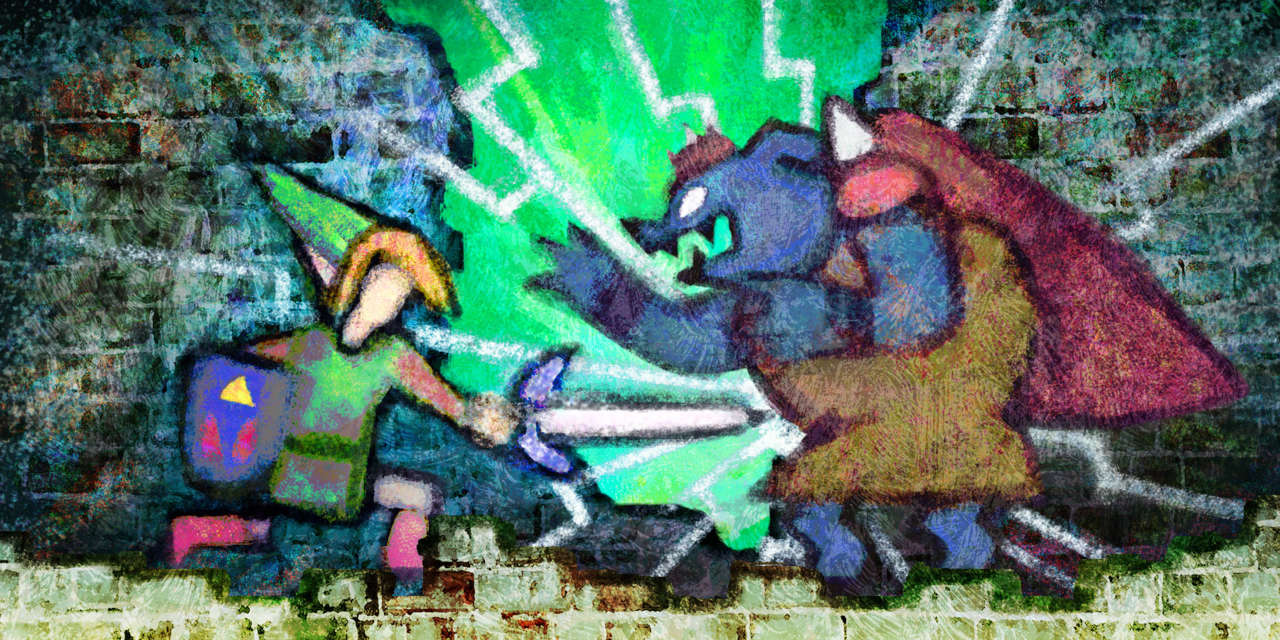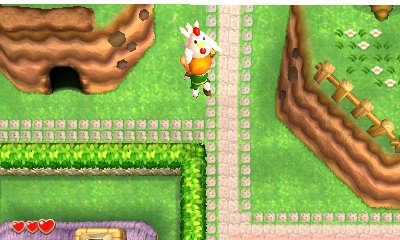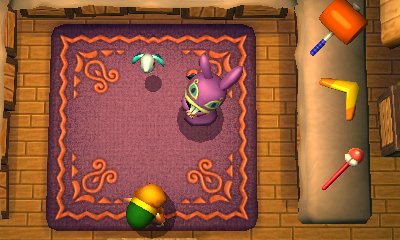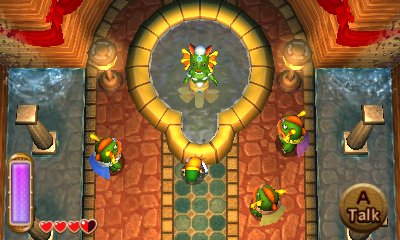It's not easy to return to a place after a 21-year absence, so it's a surprise how effortless it is to slip back into the Hyrule first introduced in 1992's The Legend of Zelda: A Link to the Past. The famous green tunic, castle, and characters are all revived in this 3DS sequel, and the passing of two decades and three console generations has done nothing to dull the sharpness of Link's first triumphant swing of the Master Sword.
For those who have cherished the original over the years, the nostalgic opening moments of this loving sequel will rekindle your memories of the classic game that precedes it. The heart of A Link Between Worlds is buried firmly in the pre-3D age of the early '90s, and Nintendo has produced an almost note-for-note polygonal reproduction of the original game's Hylian overworld, complete with the triumphant boom of the series' main theme charging out of the 3DS's speakers. But while many elements of this sequel are familiar, this is a fantastic standalone adventure that excels on its own individual merits.

A Link Between Worlds is molded by the history it treats with reverence, but the game quickly creates an identity of its own. The fleeting cameo of Majora's mask, hanging on the wall of Link's house, is just one of the occasional nods from Nintendo acknowledging where the series has travelled since muddying its boots around the gardens of the original Hyrule Castle. Yet this game's accomplishment lies with Link's new ability to transform into a portrait and traverse walls. As a painting, Link is a stylised riff on a Romanesque mural beautifully animated to look simultaneously static and vibrant, with bouncy movement and flickering eyes. It's an impeccably charming effect.
The painting is the game's central mechanic, its version of a time-travelling ocarina, wind-summoning baton, or werewolf transformation, and many of the dungeons make good use of the new tool. The ability comes to him by way of Yuga, the game's main antagonist, who seeks to revive Ganondorf after the events of the original game by trapping descendants of A Link to the Past's seven sages as portraits. Link, as history has taught us, must rescue them. Many puzzles involve a two-dimensional Link wrapping himself around the walls of 3D environment to reach switches and chests nestled atop faraway platforms, slithering through thin cracks to enter new areas, or even traversing between two worlds by shimmying through the fissures that connect them.

It's not just a feature you'll use to get at the odd treasure chest, either, as Nintendo has done a fantastic job deeply intertwining every area of the game in ways that can only be accessed as a painting, as well as layering it as a required step in other puzzles. Many previous games in the series have had players use bombs start the timer on a frantic dash through a quickly-closing door, but here you'll be doing like that while instinctively jumping into the wall and shifting around to another platform. The fact that navigating the world as a painting becomes second nature is a huge accomplishment: it's so central to A Link Between Worlds that I couldn't possibly imagine the game without it.
The rest will be immediately familiar to those who know the Legend of Zelda series, largely because A Link Between Worlds treads the well-worn path of previous games. There is, as there always is, a comfort to this familiarity, although A Link Between Worlds feels like the most direct iteration the series has ever seen. Even the structure of the adventure is extremely similar to that of A Link to the Past, where a few hours thundering through three opening dungeons is rewarded with the Master Sword, before introducing the dark world alongside another batch of seven dungeons.
Nintendo has designed the first Zelda game where you feel free.
At the same time, though, you're encouraged to thoroughly and openly navigate Hyrule, a revelatory change which makes this adventure feel free of the series' previous restrictions. Puzzles in the overworld are no longer something you think to come back and tackle later, when you've unlocked your full suite of tools and weapons, but something you'll want to work out how to accomplish right then and there.
The game opens up further, too, when you reach the dark world, now known as Lorule. You can tackle the Lorule dungeons in any order you wish, which massively impacts how the bulk of this game plays out. Whereas many other Zelda games cordon off areas behind obstacles requiring items obtained in other dungeons, creating a set of talents and player options that slowly unfurl, A Link Between Worlds puts the game's arsenal in the hands of Ravio, a shopkeeper in a bunny suit who sets up his stall in Link's house. You simply rent the item you're after--be it hookshot, boomerang, or fire rod--and off you go. Maybe it's to your next dungeon, or that obstacle you saw a minute ago that you reckon you could thump out the way with your new hammer, or maybe you just haven't explored Misery Mire in a while. Nintendo has designed the first Zelda game where you feel free.
The shift towards renting items makes the game far more reliant on accumulating currency than before, with wayward pots, tall grass, and treasure chests in dungeons regularly forking out hundreds of rupees. It's a beautifully cyclical system, with item renting taking away the barriers of exploring the world and getting rich finding secrets, but also taking the money found in those hard-to-reach treasure chests and hidden rooms. Rented items, which generally cost 50 rupees, are lost if Link dies, but can eventually be bought outright for closer to 1,000 rupees. There are enough rupees scattered around the game for fastidious players to buy everything, but I found myself only purchasing my favourite items (bombs, arrows, and the hookshot) and simply renting the rest.

Ravio's shop also exists to serve the puzzles of the game's main dungeons, with each particular item getting its own dedicated moment to shine in some of the finest dungeons to ever feature in the series. The sand rod, for instance, lets Link cross gaps in the Desert Palace by conjuring up rows of cross-crossing pillars that inadvertently trigger as many problems as they fix, springing up at the wrong height or heading in the wrong direction, forcing you to leap into walls in order to figure out the correct path.
But, of course, there's no set path or order. You could just as easily take the hookshot to the Swamp Palace, and clip onto sets of valves that raise and lower the levels across sets of rooms in interconnected waterways, or use the lamp in the Dark Palace for a string of puzzles that need the lights to be on or off, with a couple that seem to be asking for both simultaneously, at least until you work out what's going on. These are tight, compact dungeons that are densely populated, and one of my favourite things about A Link Between Worlds is that it's the first game in a long line of modern Zelda titles that has routinely left me stumped in the middle of a dungeon, scratching my head, aimlessly running around in circles trying to figure out what I'm missing.
Though it can be bizarre to think that something so occasionally familiar can still be so fresh and engaging, A Link Between Worlds is itself a unique experience.
It probably sounds odd that this is a game at its best when it feels like you're untangling a skein of yarn, but much of the series' joy comes from having a tightly-woven series of locked doors and blocked corridors slowly and surely peeling away until you feel like you've become the master of this tiny domain. While this is a more perplexing game than many of its modern counterparts--especially if you're looking to rummage through all of its treasure chests--there are Play Coin-guzzling Hint Ghosts that will put you on the right path if they so desire. I'd advise against cheating yourself the joy of figuring it out, though; the challenge here is perplexing instead of frustrating, and it's worth enduring those occasional bouts of confusion for the satisfaction that comes from your eventual success.
This is a lengthy game, and getting stuck in its intricacies is a delight. Without a 3D world to explore, and the difficulties of targeting and locking on that come with it, A Link Between Worlds is pure top-down puzzle-solving in fast, fluid areas. Combat is quick and punchy, and many of the boss fights are tricky enough to elicit the kind of fear and tension (especially when you start worrying about losing your rented items) that's been absent from the series for a long time. Each dungeon builds to this confrontation, which comes as a thrilling, thumping, all-action crescendo after all the careful and thoughtful exploration.
Many of these boss encounters are riffs on adversaries originally encountered in A Link to the Past, albeit with a new spin on how they need to be defeated. And what fights they are: you challenge a monster guarded by a thick shield of ice, battle against a spinning whirligig that threatens to push you down a chasm, and take on a gaggle of eyeballs, a raging giant fist, a skeleton thief, or a monster with a noggin encrusted with a thick rupee shell. Each has their own particular weakness that needs to be exploited, with my personal favourite involving confusing one boss by running up to its shield and switching to Link's portrait form.

In many other areas, A Link Between Worlds' main refinements over its predecessor come from smoothing out the experience. You can fly to fixed points around both Hyrule and Lorule with the aid of a Witch's broomstick, the Fortune Teller near Kakariko Village now gives you direct advice rather than cryptic suggestions, and the map (displayed on the bottom screen of the 3DS) can be easily navigated, zoomed in, and annotated with pins. These features make exploration easy--you can head off the beaten path in an effort to reach that tantalising treasure on the horizon, because you know you can just warp back when you're done--and allows you to focus on the exact areas, or dungeons, you want to be pursuing. Coupled this with the game's loose structure and you're left with the most open Zelda game in the series.
The aesthetic, however, does not effortlessly transition to a polygonal world. Link looks closer to Bilbo Baggins than he does Legolas, albeit with blonde hair rather than the purple rinse of the SNES original, and the game's versions of trees look more like giant bulbous pumpkins. It's more of a functional visual upgrade rather than an artistic one, though the end result is pleasant enough.
One visual area that Nintendo does excel at, however, is the game's 3D effect, which adds a surprising amount of depth and character to the game, and is easily the most successful inclusion of the handheld's 3D slider since Super Mario 3D Land. I'm not normally one for 3D, but I wouldn't play A Link Between Worlds any other way. It's a fast-paced adventure, then, and one that feels like Nintendo paring back the layers of complexity the series has added in recent years and simply returning to the basics--this is worlds apart from the train track metagame of Spirit Tracks, the last dedicated handheld Zelda. Though it can be bizarre to think that something so occasionally familiar can still be so fresh and engaging, A Link Between Worlds is itself a unique experience. There's a lingering sense that by this point Nintendo is just running victory laps around a set of mechanics they perfected decades ago but, at the end of the day, none of that matters: this is simply an absolute treat to play.